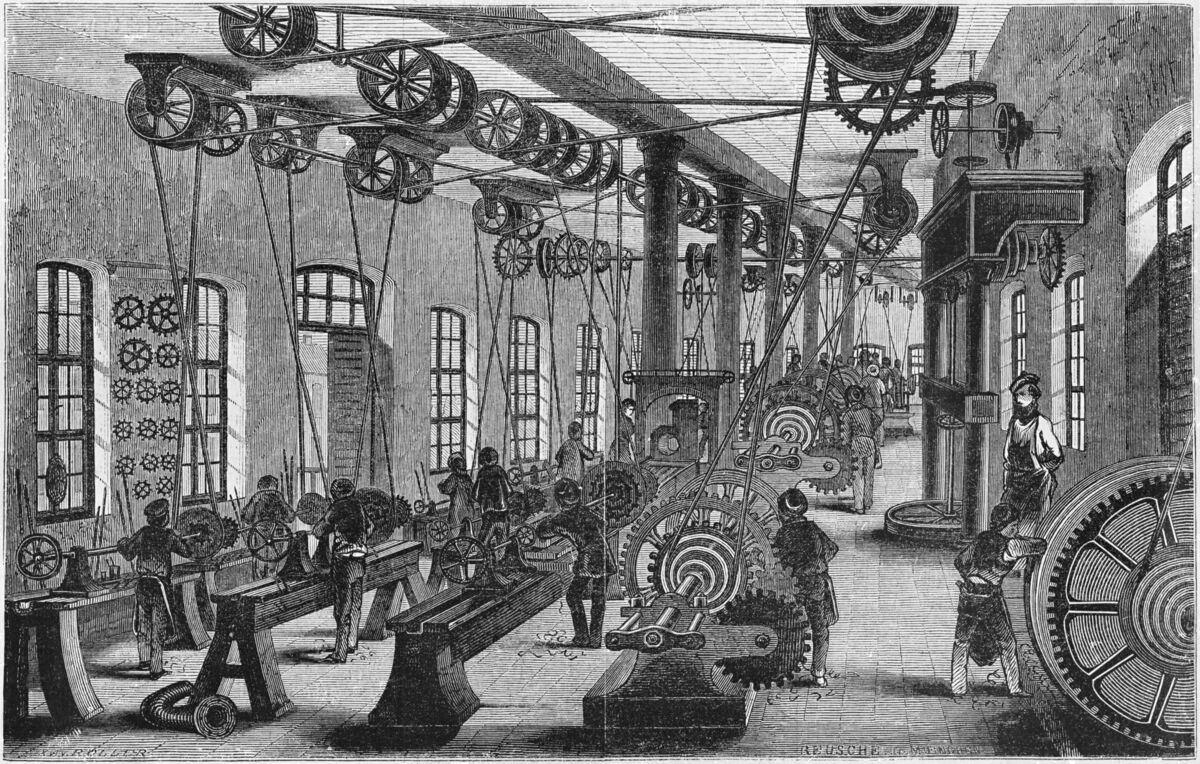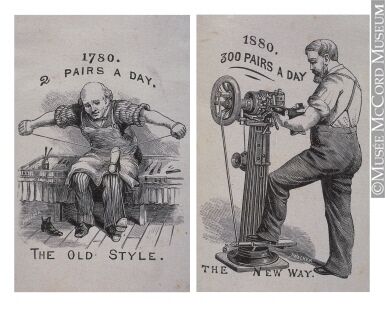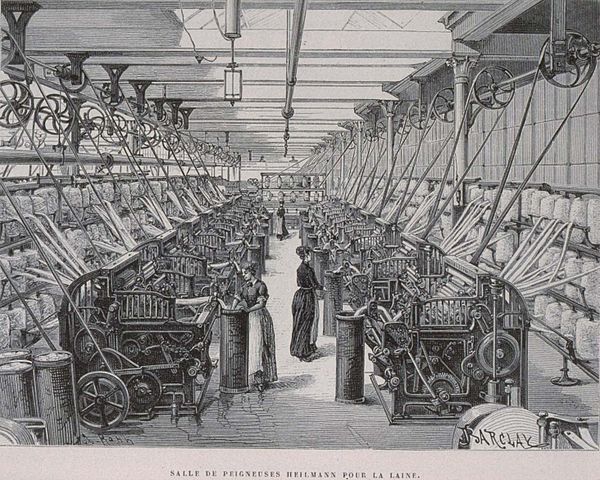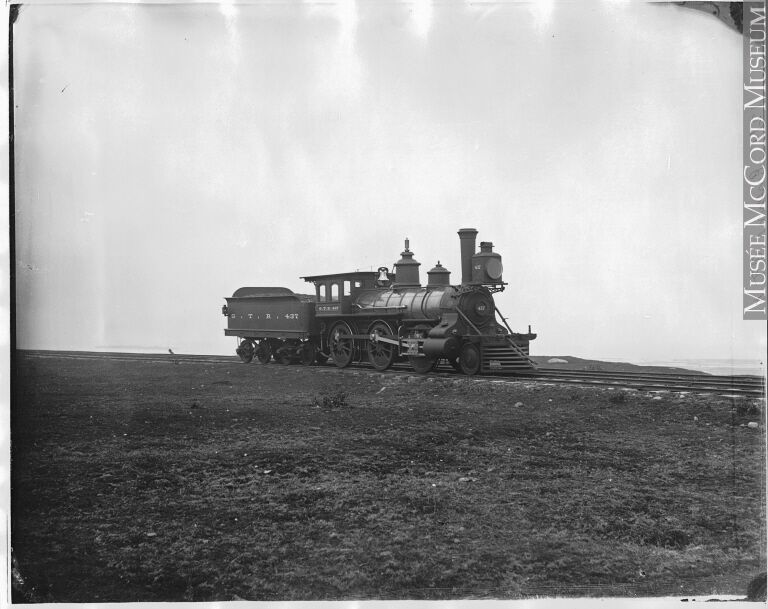The 1850s witnessed the first phase of industrialization to occur in United Canada. Most of the first industries were located near waterways and big cities, including Montreal and Quebec City in Lower Canada, as well as Toronto in Upper Canada. Setting up industries near waterways enabled the different resources and products to be transported by boat.
The development of new machinery greatly increased the speed of production, so workers could make more products in less time. In addition, workers were no longer required to be particularly skilled; as long as they understood how the machine worked, they could perform the task. This is called the mechanization of production.
A new economic system called industrial capitalism developed during this phase of industrialization. Investors needed capital to build factories, pay workers and buy machines so they could start production. These investors were either British or Canadian in origin and belonged to the middle class, who had made their money from the timber trade.
In an industrial capitalism system, investors control production and sell products to turn a profit. They then take this profit, reinvest it by building new factories or buying new machinery to earn more profit. The main aim of investors is to always earn more revenue than the amount they initially invested. In industrial capitalism, only the owners benefit from how profitable an industry is, while workers earn a very low wage in return for their work. Working conditions were generally miserable. The workday was very long and workplace accidents were common.

Source: Drehen zu Beginn [Illustration], Leipziger Illustrierte Zeitung, 1849, Wikimedia Commons, (URL). CC0 1.0
Many banks were created during the 1850s and 1860s to lend money to investors. The Montreal Stock Exchange was also created at this time, bringing in new capital for industries.
The first phase of industrialization saw big changes in how goods were produced. Before then, craftspeople specialized in their fields and produced their products by hand using tools.
With industrialization, goods were produced much faster. They were manufactured in several stages, and each worker was responsible for one stage. This process is called a production line.

Source: La nouvelle façon : 300 paires par jour, 1880 [Ink on paper], Walker, J. H., 1880, McCord Museum, (URL). CC BY-NC-ND
Two types of industry developed during this period of industrialization. The first was the light industry, which included food, leather, textiles and timber. There were lots of bakeries, shoe factories, cigar and cigarette factories and cotton mills. The term ‘light industry’ was used because these products were ready to be used or consumed by individuals.
Workers earned very low wages and did not need much training, making them easy to replace. Women and children were often recruited to work in these factories along with men.

Source: Salle de peigneuses Heilmann pour la laine [Illustration], Barclay, A. K., 1889, Wikimedia Commons, (URL). CC0 1.0
In heavy industry, on the other hand, specialized workers were paid higher wages. Iron and steel were the main raw materials used to make carriages, rails and locomotives, which were in high demand due to the development of rail networks. In heavy industry, products were intended for companies and governments, not individuals.
Industries produced a great deal of merchandise, which had to be transported to the towns and cities in the Province of Canada and to the United States to be sold. Thanks to the Reciprocity Treaty, the Province of Canada sold an enormous amount of merchandise and resources to the United States. A number of canals and locks were built to develop maritime transport for these products, but waterways could not be used for transport during the winter due to weather conditions. In light of this, other means of transport were considered, including the construction of a large rail network. This would make it possible for the Province of Canada to efficiently transport merchandise.

Source: Locomotive et ravitailleur du chemin de fer du Grand Tronc, QC, vers 1870 [Photograph], Notman, W., 1860-1880, McCord Museum, (URL). CC BY-NC-ND
However, this project could not be achieved by just anybody, since it would be very expensive. The Grand Trunk Railway Company had the necessary capital, so it took on the task. The Great Lakes and Rivière-du-Loup were connected by a railroad that went through Montreal, allowing the industries in Toronto and Montreal to grow even more quickly. By the end of the 1870s, Nova Scotia and New Brunswick had joined the large Grand Trunk transport network, forming the Intercolonial Railway.
With the rail network built, raw materials could be quickly transported to industries. Products were then made in factories and transported to the markets where they were sold.
Along with improvements to the navigation system and the construction of railroads, many roads and bridges were built to connect various regions to cities. These projects were particularly beneficial for forested regions.
Barclay, A. K. (1889). Salle de peigneuses Heilmann pour la laine [Illustration]. Wikimedia Commons. https://commons.wikimedia.org/wiki/File:Armand_Kohl48.jpg?uselang=fr
Leipziger Illustrierte Zeitung. (1849). Drehen zu Beginn [Illustration]. Wikimedia Commons. https://de.wikipedia.org/wiki/Datei:1849_%E2%80%9EDrehen_zu_Beginn%E2%80%9C_am_Beispiel_der_Maschinenbauanstalt_Maffei..jpg
Notman, W. (1860-1880). Locomotive et ravitailleur du chemin de fer du Grand Tronc, QC, circa 1870 [Photograph]. McCord Museum. http://collections.musee-mccord.qc.ca/scripts/large.php?Lang=2&accessnumber=VIEW-1211.1&idImage=156256#description
Walker, J. H. (1880). La nouvelle façon : 300 paires par jour, 1880 [Ink on paper]. McCord Museum. http://collections.musee-mccord.qc.ca/scripts/viewobject.php?Lang=2§ion=196&accessnumber=M930.50.5.142&imageID=303037&pageMulti=1